
In organology, the study of musical instruments, many methods of classifying instruments exist. Most methods are specific to a particular cultural group and were developed to serve that culture's musical needs. Culture-based classification methods sometimes break down when applied outside that culture. For example, a classification based on instrument use may fail when applied to another culture that uses the same instrument differently.
A membranophone is any musical instrument which produces sound primarily by way of a vibrating stretched membrane. It is one of the four main divisions of instruments in the original Hornbostel-Sachs scheme of musical instrument classification.
The music of Sri Lanka has its roots in five primary influences: ancient folk rituals, Hindu religious traditions, Buddhist religious traditions, the legacy of European colonisation, and the commercial and historical influence of nearby Indian culture—specifically, Kollywood cinema and Bollywood cinema.
A hand drum is any type of drum that is typically played with the bare hand rather than a stick, mallet, hammer, or other type of beater.
Gagaku is a type of Japanese classical music that was historically used for imperial court music and dances. Gagaku was developed as court music of the Kyoto Imperial Palace, and its near-current form was established in the Heian period (794–1185) around the 10th century. Today, it is performed by the Board of Ceremonies in the Tokyo Imperial Palace.
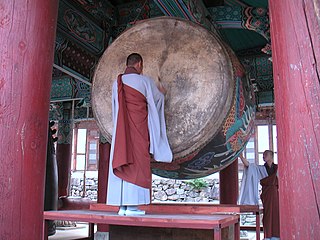
Ceremonial drums are membranophones and idiophonic slit drums, which are played in a ritual context cult, religious or ceremonial social occasions by indigenous peoples around the world, often accompanied by singing or chanting.

The idakka, also spelt edaykka/edakka, is an hourglass-shaped drum from Kerala in south India. This handy percussion instrument is very similar to the pan-Indian damaru. While the damaru is played by rattling knotted cords against the resonators, the idakka is played with a stick. Like the damaru, the idakka's pitch may be bent by squeezing the lacing in the middle. The idakka is slung over the left shoulder and the right side of the instrument is gently beaten with a thin curve-ended stick. It is played in temples and in performances such as Kathakali and Mohiniattam classical dance.

The buk (Korean: 북) is a traditional Korean drum. While the term buk is a native Korean word used as a generic term meaning "drum", it is most often used to refer to a shallow barrel-shaped drum, with a round wooden body that is covered on both ends with animal skin. Buk are categorized as hyeokbu which are instruments made with leather, and has been used for jeongak and folk music.
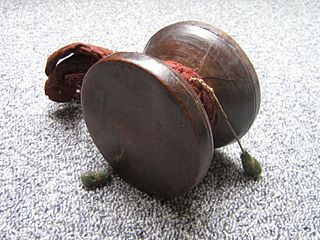
A damaru is a small two-headed drum, used in Hinduism and Tibetan Buddhism. In Hinduism, the damaru is known as the instrument of the deity Shiva, associated with Tantric traditions. It is said to be created by Shiva to produce spiritual sounds by which the whole universe has been created and regulated. In Tibetan Buddhism, the damaru is used as an instrument in meditation practices.
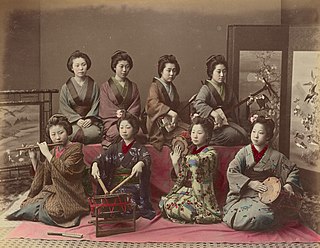
Traditional Japanese musical instruments, known as wagakki (和楽器) in Japanese, are musical instruments used in the traditional folk music of Japan. They comprise a range of string, wind, and percussion instruments.
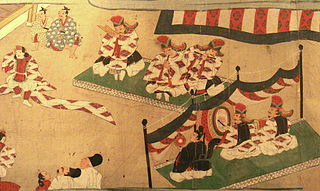
Traditional Japanese music is the folk or traditional music of Japan. Japan's Ministry of Education classifies hōgaku as a category separate from other traditional forms of music, such as gagaku or shōmyō, but most ethnomusicologists view hōgaku, in a broad sense, as the form from which the others were derived. Outside of ethnomusicology, however, hōgaku usually refers to Japanese music from around the 17th to the mid-19th century. Within this framework, there are three types of traditional music in Japan: theatrical, court music, and instrumental.
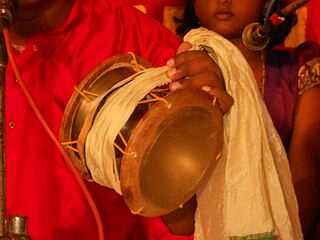
The udukkai, udukai or udukku is a member of the family of membranophone percussion instruments of India and Nepal used in folk music and prayers in Tamil Nadu. The drums are an ancient design of hourglass drums similar to the northern damaru and southern idakka. Its shape is similar to other Indian hourglass drums, having a small snare stretched over one side. They are played with the bare hand, and the pitch may be tered by squeezing the lacing in the middle. It is made of wood or brass and is very portable. It originated in Tamil Nadu as well. Other members in the family include thehuruk, hurkî, hurko, hudko or hudka, utukkai.
Traditional Thai musical instruments are the musical instruments used in the traditional and classical music of Thailand. They comprise a wide range of wind, string, and percussion instruments played by both the Thai majority as well as the nation's ethnic minorities.

Pellet drums, or rattle drums, are a class of membranophone, or drum, characterized by their construction and manner of playing. They have two heads, and two pellets, each connected by a cord to the drum. The damaru, which is used in Tibet, Mongolia, and India, is an hourglass drum that is grasped by its waist with the hand twisting back and forth, causing the pellets to strike the heads in a rhythmic fashion.photo In China, Korea, and Japan, pellet drums are affixed to or pierced by a vertical rod or pole, and, depending on the instrument's size, the rod or pole is rotated back and forth along its axis either with one or both hands or between the palms, causing the pellets to strike the heads in a similar manner.
Directly struck membranophones is one of the sub-categories of musical instruments found in the Hornbostel-Sachs system of musical instrument classification. The type of membranophones or drums found in this group are those instruments that produce sound when struck directly by the performer. The membrane of these drums is hit with a stick, the hand, or something else. Drums that produce sound by means of plucking an attached string or by means of friction are grouped in a different category.
The hakgediya is a type of conch shell which is used as a kind of trumpet in the traditional ritualistic music and religious folk art-music of Sri Lanka, which has been somewhat influenced by Indian music. The hakgediya is an aerophone, or Susira. This instrument was used mainly in Theravada Buddhist artistic rituals which also involved other categories of instruments such as Ghana, Avanaddha, and Tat.

There are several overlapping schemes for the classification of percussion instruments.

Kundu is a pidgin name in Papua New Guinea for an hourglass drum used to accompany formal occasions, religious ceremonies and for celebrations. This drum is emblematic of Papua New Guinea and it appears on the country's coat of arms.

The Udukku, also known as Udukkai, is an Indian traditional percussion instrument of South Indian, popular in Kerala, Tamil Nadu and north and east parts of Sri Lanka. It is similar to Damaru and Edakka, larger than the former but smaller than the latter.













